Many species have tails, but there are some species that have tails so long they contribute to over half the species’ size. Long tails aren’t just for looks. Tails are very useful tools for creatures who have them. In this article, we explore a variety of species with some of the longest tails in the world!
What Are Tails Made Of?
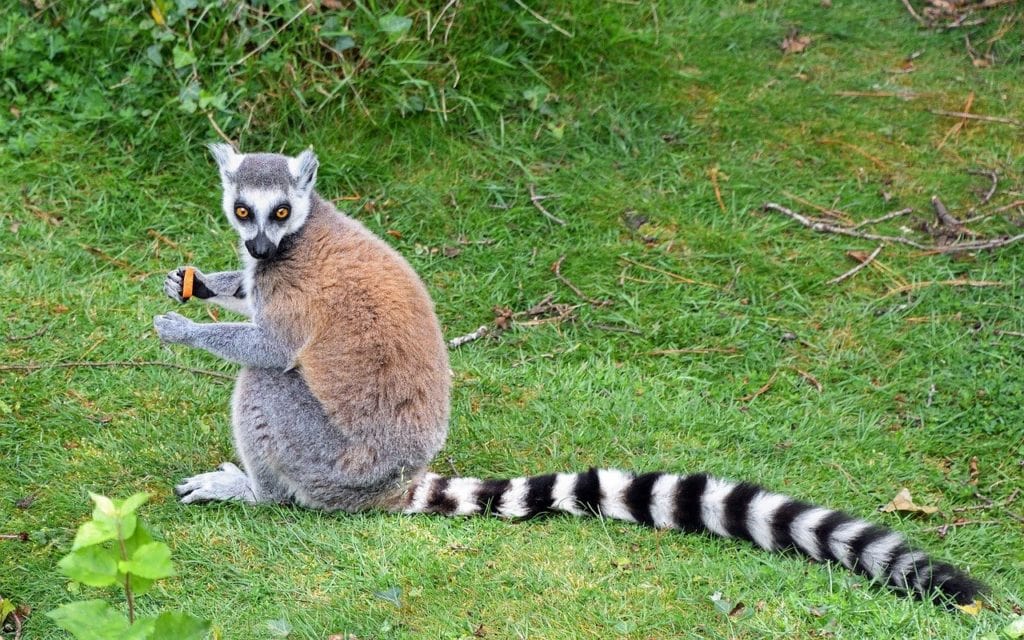
Tails are made of a series of caudal vertebrae. The rest of the tail is made of muscles and tissues to enable movement. Vertebrae are the series of bones that make up the backbone. Vertebrae are split up into five different categories, each with a specific function that supports the body.
The five types of vertebrae are:
- Cervical (neck)
- Thoracic (ribcage)
- Lumbar (abdomen)
- Sacral (pelvis)
- Caudal (tail)
The number of caudal vertebrae in a species depends on the length of the tail. The Long-tailed Pangolin has the most of all living mammals with 49 caudal vertebrae.
What Is the Purpose of Long Tails?
Grasping
Tails serve a purpose specific to each species. Prehensile tails are a special type of tail that allows the animal to grasp things. This is especially apparent for arboreal species that climb throughout tree tops and use it as an extra arm or leg to grab and hang on to branches or food.
Balance and Navigation
Long tails are commonly used to help an animal balance, especially if they have smaller bodies or are less sturdy. Sharks with long tail fins use them to help navigate throughout the ocean.
Defense
Some species use their long tail as a method of defense. Stingrays have barbs at the end of their tail to help protect themselves from predators. Other species may use their tail as a kind of whip or shield to deter predators.
Communication and Mating
Animals with long tails often use their tails as a form of communication to help find each other or warn of danger. This is especially apparent for animals that live in tall grasslands and would not be able to see each other otherwise. Birds use their tail feathers for courtship and impressing mates.
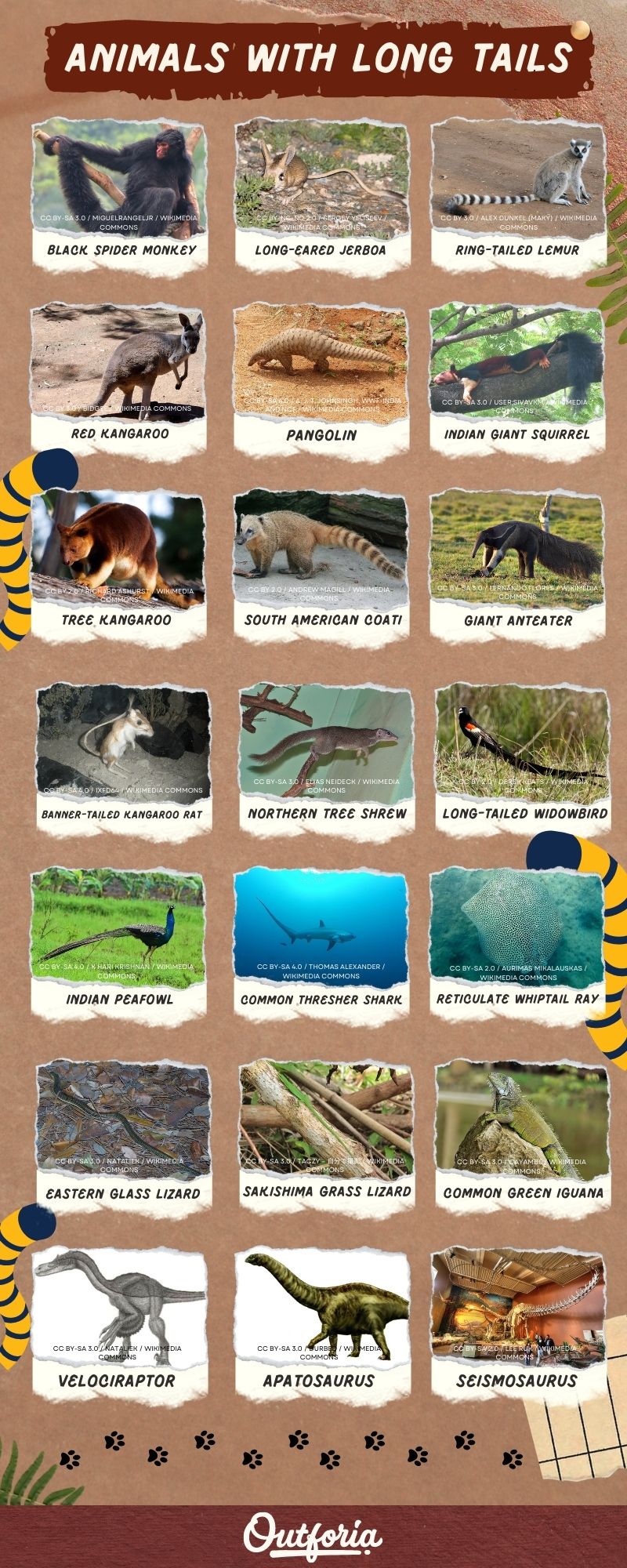
Share This Image On Your Site
<a href="https://outforia.com/animals-with-long-tails/"><img style="width:100%;" src="https://outforia.com/wp-content/uploads/2022/04/Animals-with-long-tails-infographics-04052022.jpg"></a><br>Animals with long tails Infographic by <a href="https://outforia.com">Outforia</a>Mammals With Long Tails
1. Black Spider Monkey (Ateles paniscus)
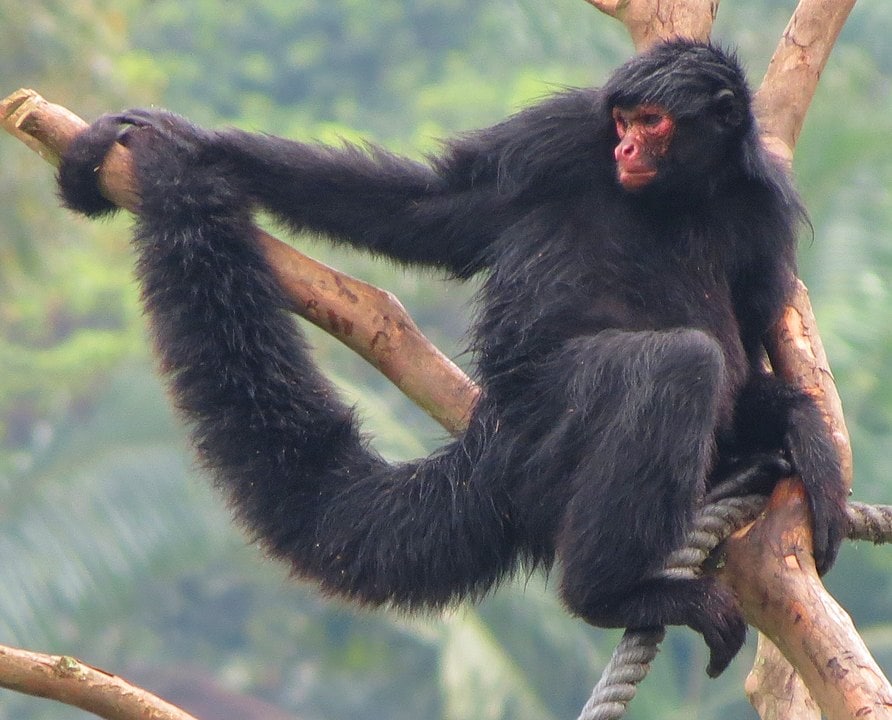
The Black Spider Monkey has a long, prehensile tail that assists in swinging between trees high in the canopy. Their body length ranges between 16-24 inches (41-61 cm) and their tail ranges from 24-32 inches (61-81 cm) in length alone. That means their tail contributes to at least half of their total body length!
Black spider monkeys live in the tropical and subtropical rainforests of Central and eastern South America. There are 6 other spider monkey species that live in South America, but black spider monkeys are one of the largest.
They have fluffy black fur with a red face, giving them the nickname “red-faced spider monkey”. Younger monkeys have a dark face that changes to red over time. Just like other types of monkeys, their diet consists mainly of fruit, especially during the wet season, but they also munch on leaves, flowers, and seeds.
2. Long-eared Jerboa (Euchoreutes naso)

Long-eared jerboas are small rodents that live in deserts of the Southeast Asia region. As their name suggests, these small rodents have big ears with a small body and lengthy tail. They can grow between 2.75-3.5 inches (7-8.9 cm) in length, not including the tail. Their tails are double the size of their body and can be as long as 6.5 inches (16.5 cm).
These desert creatures are a light sandy brown color to help them blend into their habitat. They have a distinct tail that is light brown with a dark brown to black tip. They use their tails to help them balance as they hop along the sandy desert.
Their front legs are short to easily hold and feed on insects. Their hind legs are larger and act as springs, allowing them to hop quickly. Little research has been done on their reproduction, however they are thought to be polygynous due to their close relation to the Dipodidae family.
3. Ring-tailed Lemur (Lemur catta)
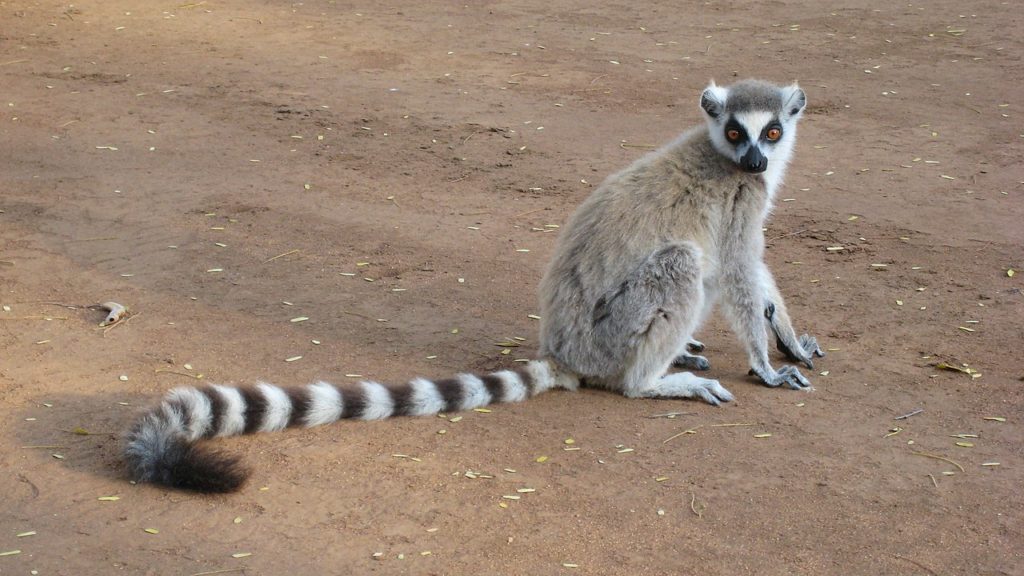
The notable Ring-tailed Lemur is easily recognizable for their long, busy tails that have a distinct alternating black and white ring pattern. Their body and facial markings resemble that of a raccoon as they have black rings around their eyes and black noses. Their fur is light tan and gray.
The Lemur tail is approximately 24 inches (61 cm) making the total length of their body 41 inches (104 cm) from head to tail. They use their tails to help them balance as they climb trees and for communication when traveling, but it is not prehensile.
They also use their tails as a visual to help their group members, called troop-mates, see others when traveling. Ring-tailed lemurs live in the southern region of Madagascar in the tropical forests.
Although they like to eat and sleep in the forest canopy, they are highly terrestrial and spend more time on the ground. Most of their diet consists of insects, bark, flowers, and invertebrates.
4. Red Kangaroo (Osphranter rufus)
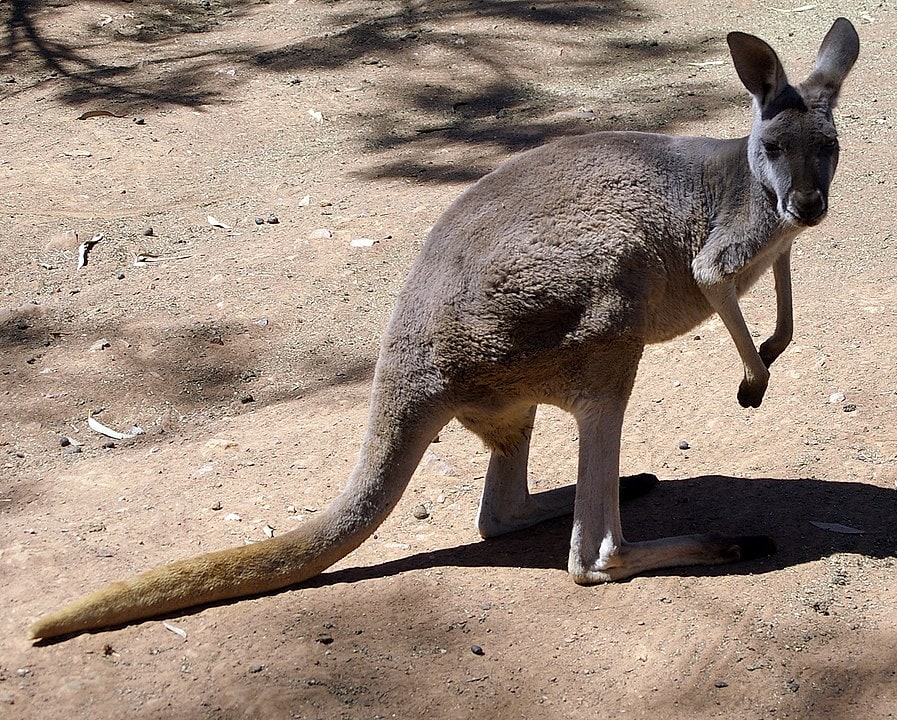
Red kangaroos have heavy, long tails. Adult males are larger than females and stand as tall as 5.8 ft (1.8 m). Their tails make up about half their total body length at 3.3 ft (1 m). The kangaroo tail is very muscular and acts as an additional leg to help with balance and conserve energy.
Males and females differ in color with the exception of both having tan to cream colored bellies. Males have orangish-red fur, while female fur is blue-gray. They have distinct white facial patches on their cheeks that help distinguish them from other kangaroo species.
Red kangaroos live in the grasslands, deserts, and woodlands of mainland Australia. These kangaroos breed year-round. Females have a unique reproductive ability called embryonic diapause which allows females to delay having birth until their current baby leaves their pouch.
These kangaroos are adapted to their dry environments as they can live off little water when it is scarce. They are herbivores and mainly feed on grasses, leaves, and forbs.
5. Pangolin (Pholidota)
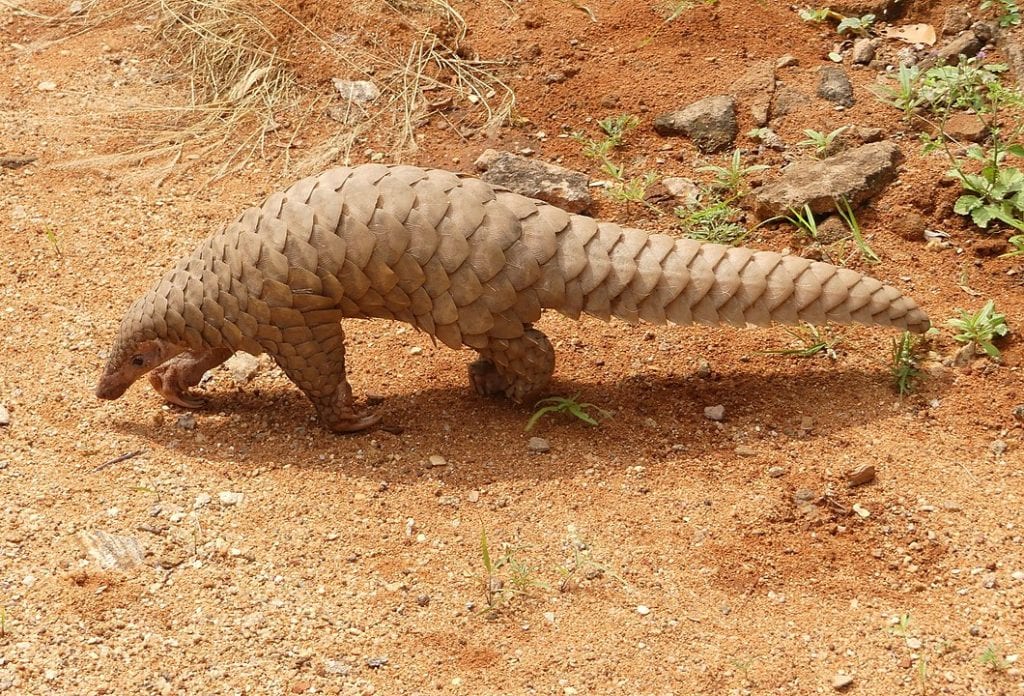
Even though they have scaly skin like reptiles, the Pangolin is a mammal. Their scales are made of keratin and provide them with protection. They are sandy brown in color and their body is long and slender with a small head.
Pangolins are in the Manis genus in the Manidae family. There are eight different species of Pangolins. Depending on the species, their size can range between 12-60 inches (30-152 cm) in length. Their tails can reach lengths up to 28 inches (71 cm), taking up almost half of their total size.
The features of a Pangolin resemble armadillos as they are able to curl up into a ball and use their hard scaly shell as armor. They use their tail as protection by wrapping it around their body and it also helps them balance.
Along with their long tails, Pangolins have an exceptionally long, sticky tongue. They use it to reach into small cavities to feed on termites and ants. Pangolins live in the forests and grasslands of Southeast Asia.
6. Indian Giant Squirrel (Ratufa indica)
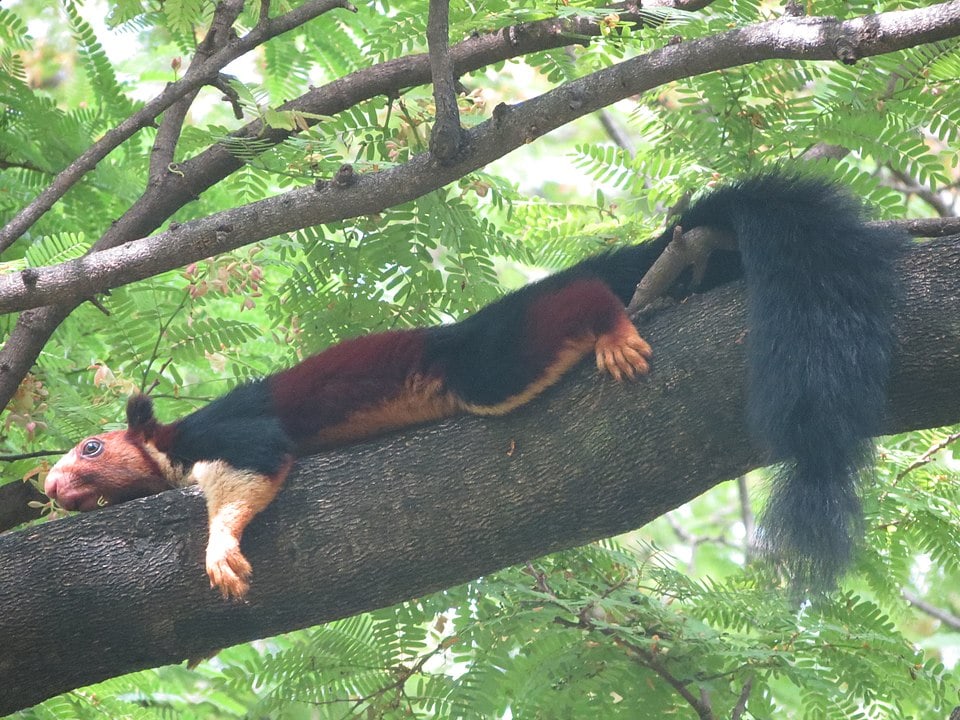
Also known as the Malabar Giant Squirrel, the Indian Giant Squirrel is an arboreal squirrel species that lives in the tropical forests of India. They can grow to be 10-18 inches (25-46 cm) long and have a long, bushy tail that’s about the same length as their body.
They mainly use their tail for balance while climbing and leaping amongst trees. They can leap at great lengths between tree limbs where they spend most of their time lounging and eating. Their diet consists of fruits, insects, flowers, and nuts.
Their color and size greatly differs from other common squirrels. They have a distinct coloration pattern with a reddish-brown head, cream to tan colored underbelly, and black body with reddish-maroon coloration in the middle of the back. Their tails are bluish-black.
7. Tree Kangaroo (Dendrolagus)

Tree kangaroos are not your average kangaroo species that hop along the grasslands of Australia. There are 14 different species of Tree Kangaroo that reside in Papua New Guinea, Australia, and Indonesia. They are arboreal creatures that live in high elevation forests in the mountains.
Tree kangaroos vary in size and grow to be 37-70 inches (94-178 cm) tall. Their tail can be as long as 34 inches (86 cm) and is used to help them balance on tree limbs.
Much of their diet consists of leaves, flowers, and fruits. Their population is heavily declining due to loss of habitat.
8. South American Coati (Nasua nasua)
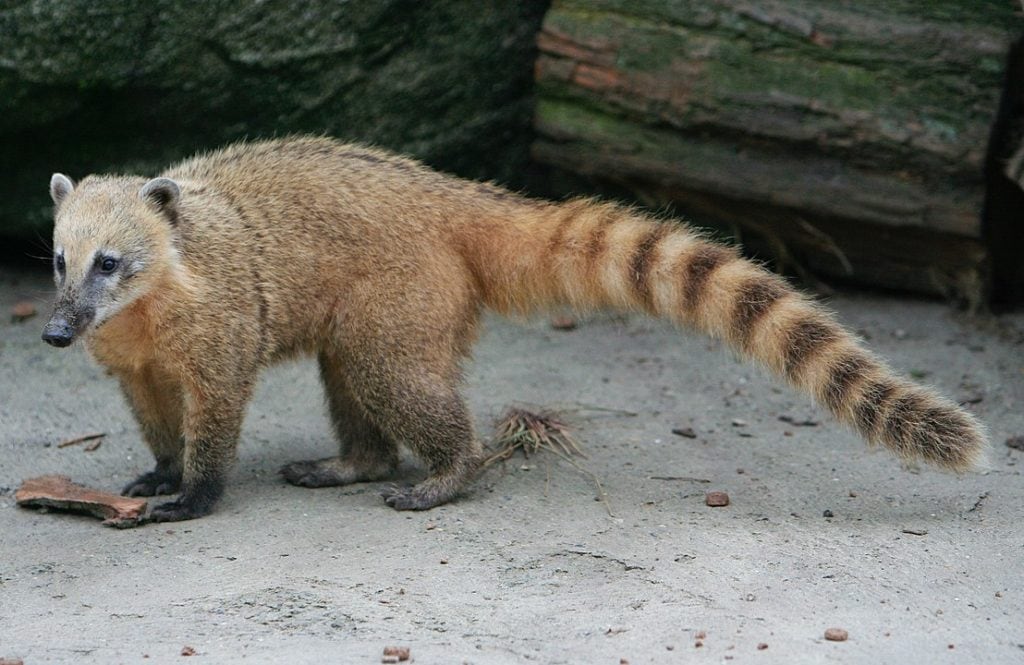
The South American Coati is an arboreal mammal of the tropical and subtropical regions of South America. They inhabit forested areas and forest edges.
Coatis have a very distinct look with a long, pig-like snout and lengthy ring-patterned tail. Their tail is just as long as their body, reaching lengths up to 27 inches (69 cm). Their tails are not prehensile and are generally used for balance and visual signs. When roaming through tall vegetation, coatis use their tail to keep their group, called a troop, together.
Their fur ranges from gray, brown, red, and light tan in color. They are omnivores and like to eat small animals, invertebrates, fruit, and bird eggs. Coatis use their sharp front claws to open logs and turn rocks over to find food. Mating occurs when fruit is abundant.
9. Giant Anteater (Myrmecophaga tridactyla)

There are four anteater species and the Giant Anteater is the largest of them all. They have long bodies that reach lengths up to 8 ft (2.4 m) with a 3 ft (91 cm) furry tail. They use their tails to help them balance as they have pretty short legs.
In addition to their long tail, giant anteaters have long snouts and an even longer 2 ft (61 cm) tongue for eating ants and termites. They have distinct color features with only their front legs being white. The rest of their body is various shades of gray, black, and brown.
Giant anteaters are a vulnerable species with some populations extinct in certain areas of their range. They inhabit the tropical forests and grasslands of Central and South America.
10. Banner-tailed Kangaroo Rat (Dipodomys spectabilis)
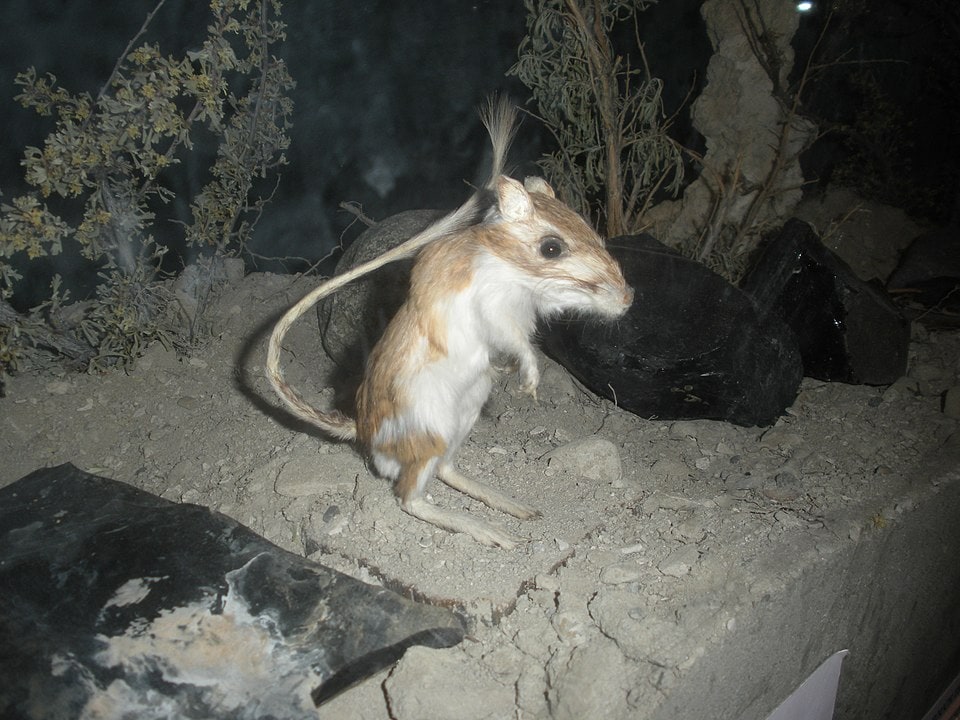
A survivalist of the desert, the Banner-tailed Kangaroo Rat inhabits the sandy deserts and grasslands of the western United States.
These rodents have a large head, small body, long hind legs, and a long tail. They grow to be 3.5-5.5 inches (9-14 cm). Their tails are typically the same length as their body or longer, reaching lengths of 6.5 inches (16.5 cm).
Kangaroo rats use their tails to help them balance and their hind legs act as springs enabling them to jump long distances to escape from predators. They are various shades of brown with white markings that help them camouflage in their environment.
They spend much of their time living in burrows and have a fairly short lifespan of 2-5 years. These little creatures have pouches on their cheeks to carry seeds of desert grasses back to their burrows.
11. Northern Tree Shrew (Tupaia belangeri)

Northern tree shrews are tiny arboreal and terrestrial mammals that live in the rainforests of Southeast Asia. Although they have similar characteristics to squirrels, they are part of the order Scandentia.
Their fur is gray and olive green and they have a long snout and bushy tail. The length of their head and body ranges between 5.5-9 inches (14-23 cm) and their tail is approximately the same length as their body. They use their tail for balance and may use it as a method of communication.
Tree shrews feed on the nectar of pitcher plants. They have a symbiotic relationship with the plants as they use the plant as a food source and in return their feces is used to give the pitcher plant nutrients. They also eat various insects and fruit.
You may also like: How Long Do Squirrels Live? Longer Than You’d Think
Birds With Long Tails
12. Long-tailed Widowbird (Euplectes progne)

Long-tailed widowbirds have exceptionally long tail feathers. Their tail consists of 12 feathers, 6-8 of which grow as long as 20 inches (51 cm). They have a black head, body, wings, and tail feathers with red and white feathers on their upper wing.
They use their tail feathers as part of a courtship ritual for attracting mates. These long-tailed birds live in the southern region of Africa in swamps, marshes, and grasslands. Their diet mainly consists of seeds and arthropods.
13. Indian Peafowl (Pavo cristatus)
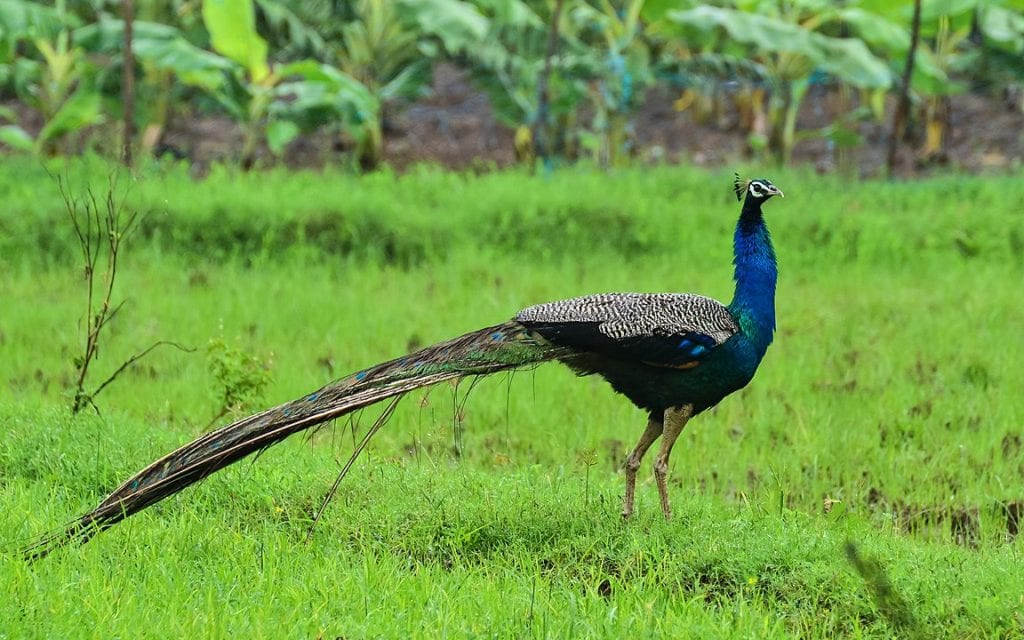
Often called a Peacock, the Indian Peafowl has a beautifully long train of tail feathers. Despite their common nickname, only males are peacocks. Females are referred to as peahens and peafowl is used when referring to both.
The size of peafowls range from 35-50 inches (89-127 cm) in length and their tail feathers, referred to as a train, can reach lengths up to 5 ft (1.5 m). Peacocks spread their colorfully sheen feathers and shake their bodies rapidly to attract peahens.
Peafowls have vibrant green and blue feathers and eye-like patterns on their train. They are native to India and Sri Lanka, but can be found in other parts of the world. They were purposefully introduced to the U.S in the 19th century.
They feed on insects, plants, and other small creatures and can live up to 20 years.
You May Also Like: The 18 Fastest Birds In The World!
Sea Creatures With Long Tails
14. Common Thresher Shark (Alopias vulpinus)
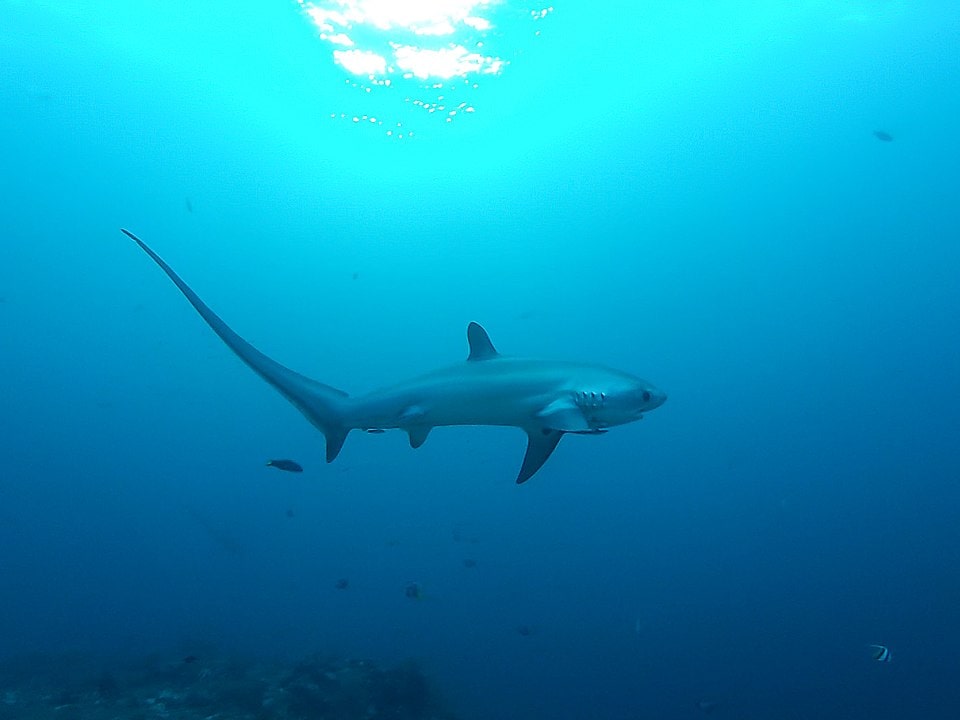
Also referred to as a Sea Fox, the Common Thresher Shark is found in several major bodies of water including off the coasts of North America and Asia. They tend to stick close to the coast and do not stray very far out to sea.
They can grow to be up to 20 ft (6 m) with smaller thresher sharks being around 5 ft (1.5 m). Their long caudal fin takes up to half of their total length. The tail fin is used to whip and stun prey as they swat sardines from shoals.
15. Reticulate Whiptail Ray (Himantura uarnak)
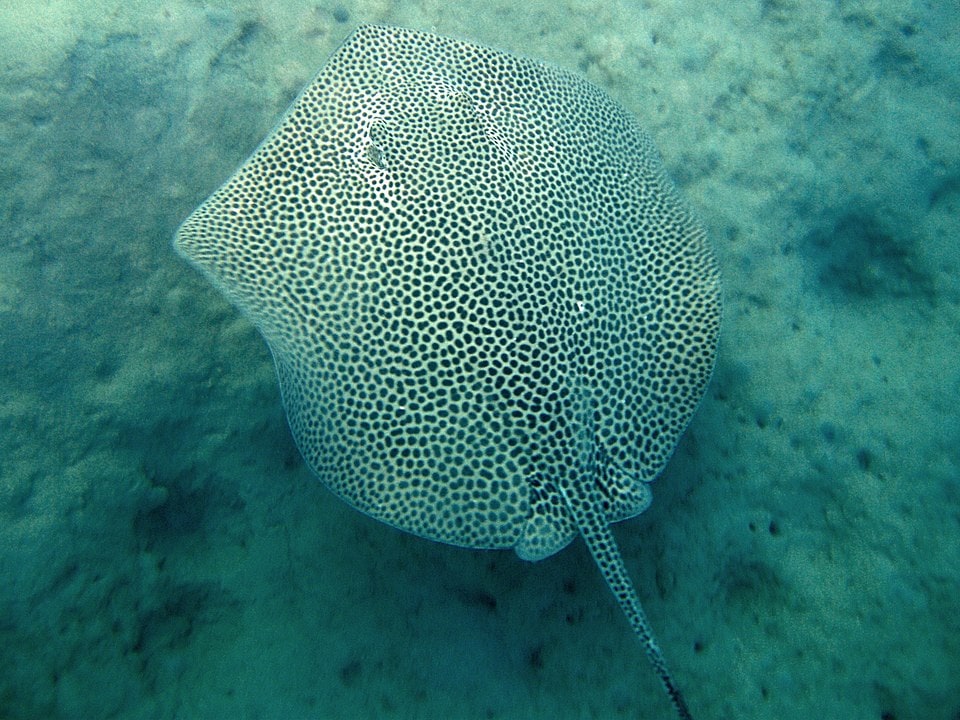
Reticulate whiptail rays are circular in shape and have long skinny tails with barbs on the end. There are approximately 69 species of whiptail rays. Much of their tail is covered in saw-tooth edges used as a form of defense from predators and can be up to 3 times its body length. It is also useful in helping them navigate.
These sea creatures are bottom feeders and like to snack on small invertebrates, shrimp, fish, sea jellies, and crabs. They hang around the seas of the Indo-Pacific and French Polynesia.
You may also like: The 3 Invasive Iguanas In Florida: Guide With Pictures And Facts
Reptiles With Long Tails
16. Eastern Glass Lizard (Ophisaurus ventralis)
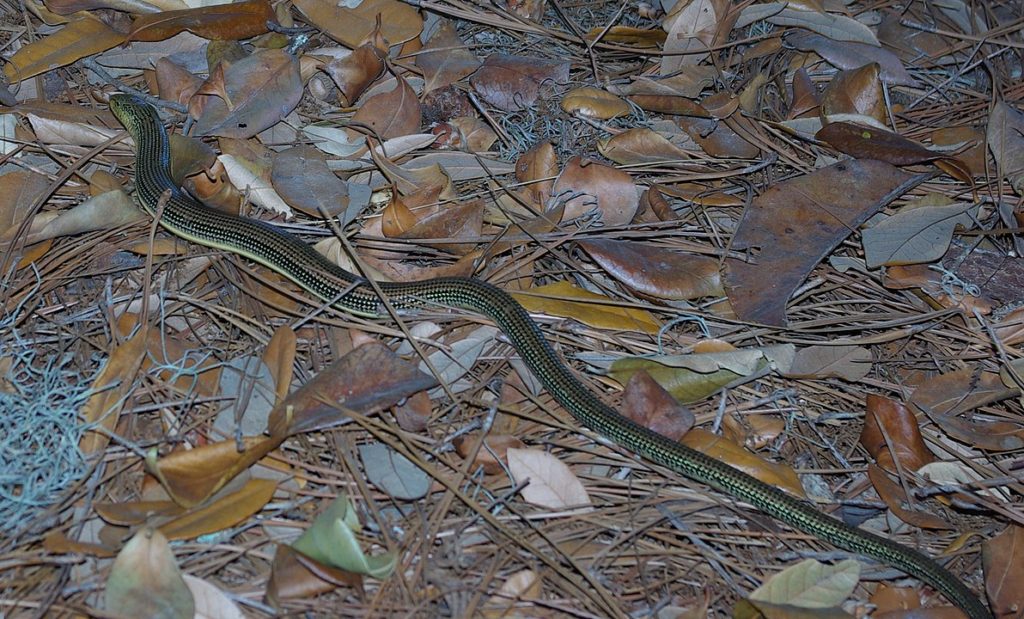
The Eastern Glass Lizard looks like a snake specie as it has no legs, but it is in fact a lizard. They are 18-43 inches (46-109 cm) long. A few characteristics that differentiate them from snakes is they have external ear openings, moveable eyelids, and cannot stretch their jaws as wide as snakes.
These slithering creatures are native to the southeastern region of the United States. Eastern glass lizards inhabit wetlands in coastal areas. They are light brown to yellowish-green. A neat characteristic these lizards have is they are able to break pieces of their tail off and regrow them over time. Their tail is used for navigation and protection against predators.
17. Sakishima Grass Lizard (Takydromus dorsalis)

Colored bright lime green, the Sakishima Grass Lizard is an endangered native species of Japan. They reside in grasslands and open forests.
They have long, slender bright green bodies and their tail is almost twice the length of their body. Their underbelly is light to pale greenish-white. They can reach up to 12 inches (30.4 cm) in length including the tail.
Little information is available about their behaviors in the wild as they are very rare creatures.
18. Common Green Iguana (Iguana iguana)
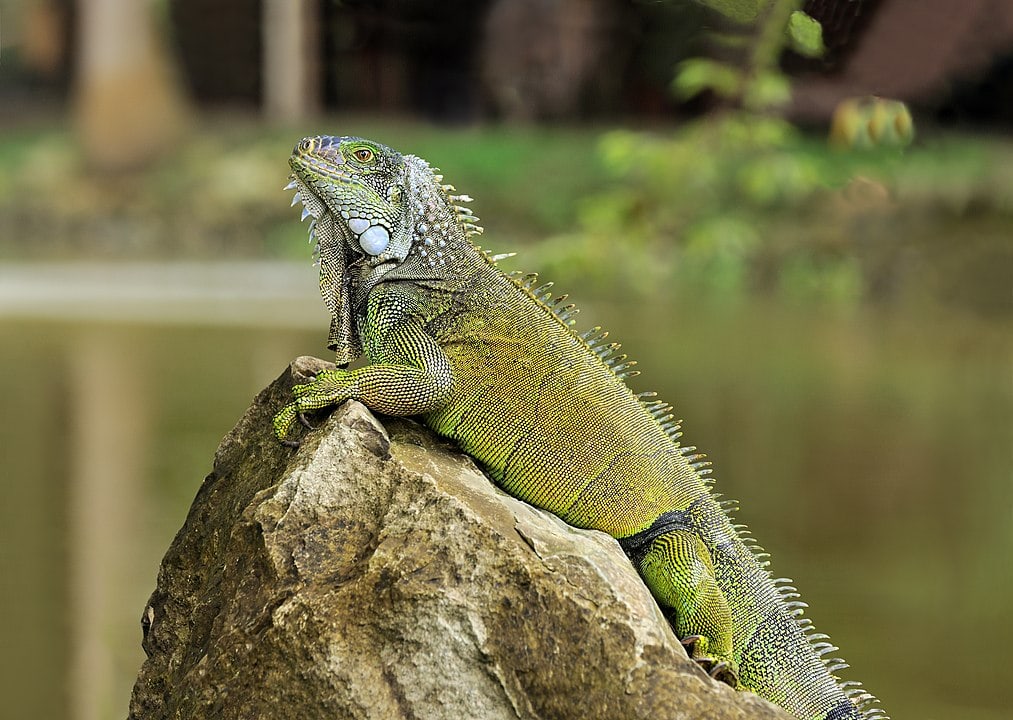
The Green Iguana is a lengthy lizard native to Central and South America. They inhabit the canopy of forested areas. They were introduced to the U.S. and can be found in the islands of Hawaii and southern Florida.
Green iguanas are bright to dark greenish-gray with brown coloration. Their tails are thick near the base and thin out towards the tip. The tail is patterned with alternating dark brown to back and light greenish-gray colors. Their total body length can reach up to 6.5 ft (2 m).
Iguanas use their tail to navigate, but the tail also acts as a defense as it is used to strike their predators. If a predator manages to capture an iguana’s tail, they are able to break it off and escape. The tail takes up about half of the iguanas body length.
These reptiles are a popular pet, but they are not easy to care for. In the wild, they can live up to 20 years. They feed on a variety of plants, leaves, and fruit.
You May Also Like: 21+ Animals With Horns (And Antlers) + Pictures And Facts
Prehistoric Animals With Long Tails
19. Velociraptor
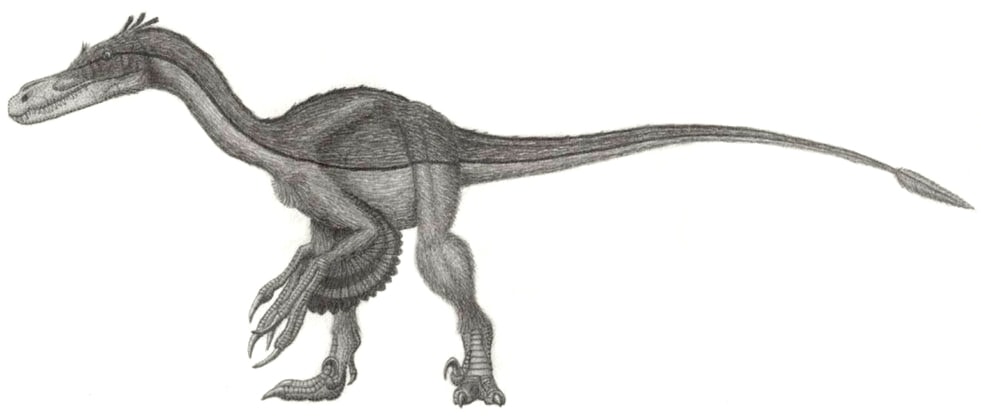
Velociraptors were small theropods that roamed the Earth 74 to 70 million years ago. Velociraptor bones were first discovered in Mongolia. Their bodies were covered in feathers and they traveled on their hind legs.
They were 6 ft (1.8 m) long and their tail was almost half the length of their body. They were carnivorous and had sharp teeth to help them rip apart their prey.
20. Apatosaurus (Apatosaurus louisae)
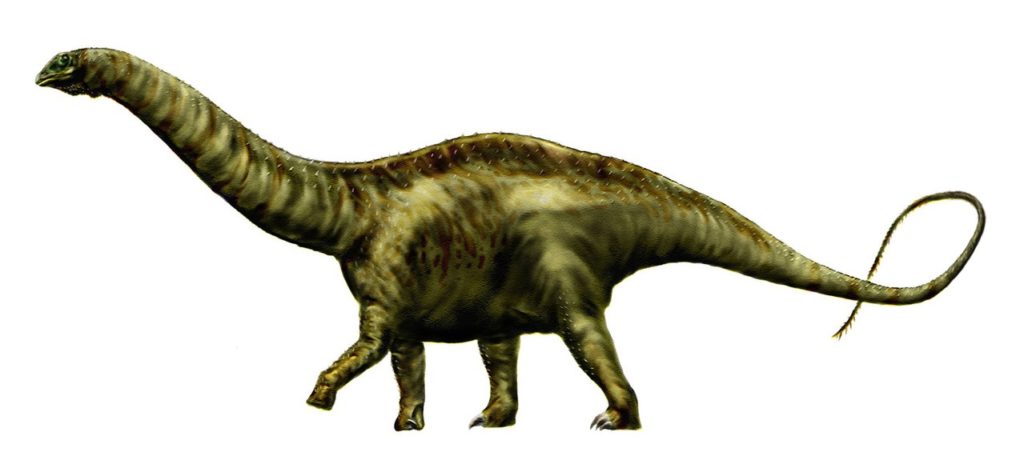
The Apatosaurus is a Sauropod species, which consisted of long-necked dinosaurs. They were herbivores with 12 ft (4 m) long necks to reach high vegetation. These dinosaurs were very large with a body length of 69 ft (21 m) and had a whip-like tail.
The bones of an Apatosaurus were first discovered in the Morrison Formation, which was a series of rocks located on the western portion of North America 154 to 145 million years ago in the Late Jurassic period.
21. Seismosaurus (Diplodocus hallorum)

The Seismosaurus was also a Sauropod that was discovered in the 1970s in New Mexico. They were approximately 120 ft (36.5 m) long with a 70 ft (21 m) tail. Researchers assume that the long tails of dinosaurs were used as a form of support and balance.
You May Also Like: What Is Poaching And Why Is It Practiced?









